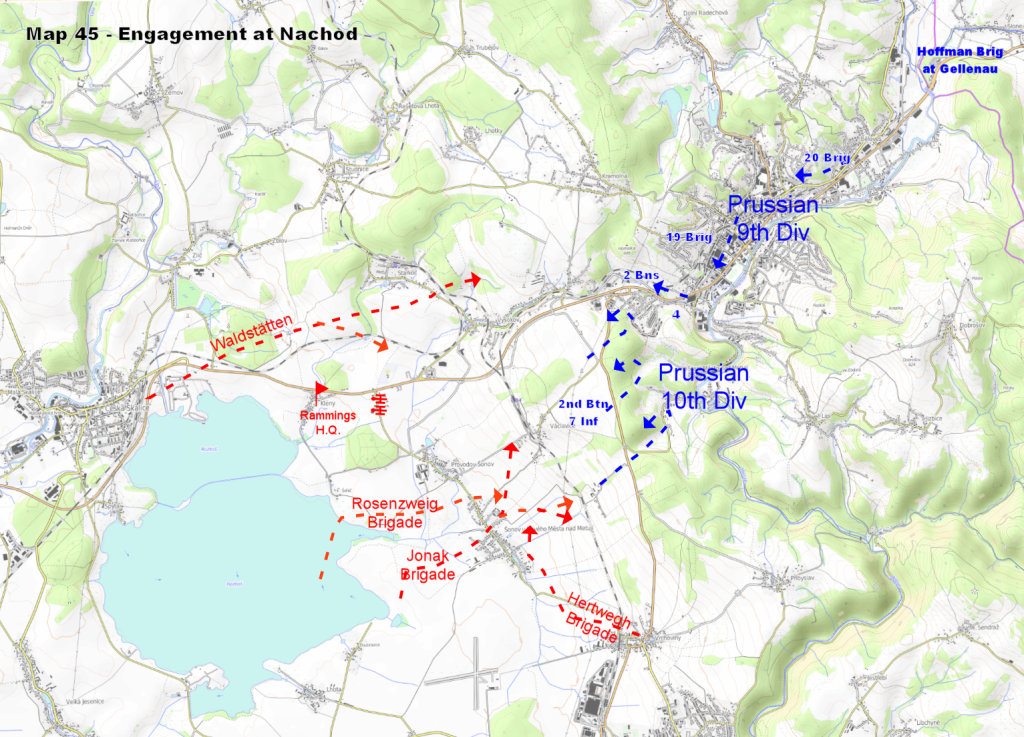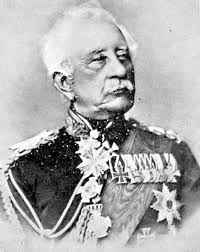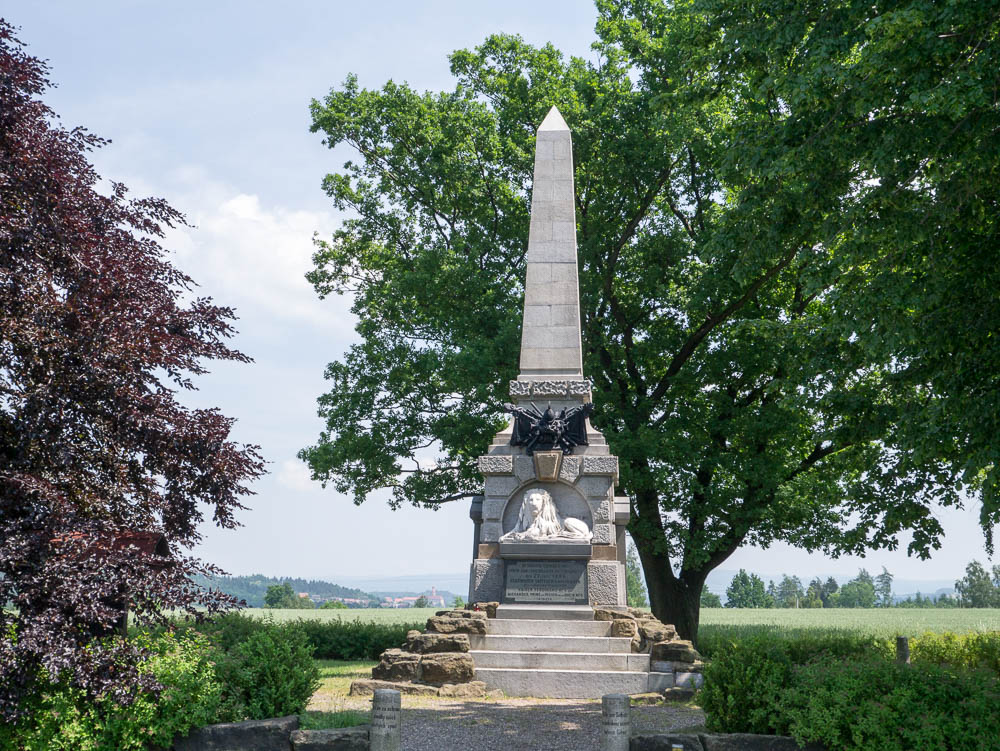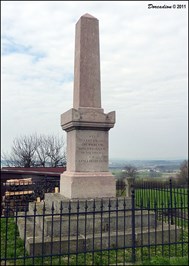
loading map - please wait...
While the Prussian 1st Army and Army of the Elbe were approaching the Iser River line, away in the eastern Riesengebirge Mountains Crown Prince Frederick William’s 2nd Army was gathering to pass through the defiles gaining access to the Upper Elbe River. By the 24th June the Guard Corps was closing on Silberberg, while the V Corps was on the road from Glatz, moving towards the pass at Nachod; the VI Corps was moving west from its position on the Neisse, with Bonin’s I Corps around Landeshut. By the 26th June all units were in readiness to cross the mountains.
At Austrian Head Quarters in Josephstad the commander of the Northern Army, Feldzeugmeister Ludwig Ritter von Benedek, was well aware of the movements of the Prussian 2nd Army, for once his intelligence gathering by well organised cavalry patrols was proving beneficial yet, despite this knowledge, he chose to follow a plan concocted by his lack – lustre Director of Operations, Major General Gideon Ritter von Krismanic. This plan entailed knocking out the Prussian 1st and Elbe armies by advancing to Gitschin and joining forces with Clam – Gallas’s I Corp and the Saxons, rather than, as should have taken precedent, striking a decisive blow against the nearest enemy, Crown Prince Frederick William’s 2nd Army. The problem was that the Crown Prince’s army advanced so rapidly that by the evening of the 26th June Krismanic’s plan had become obsolete. On that afternoon the advance guard of the Prussian V Corp were approaching the town of Nachod.
Not known for his decisiveness in times of crisis, Benedek now ordered two of his corps north to protect his right flank. Lieutenant Field Marshal Ludwig von Gablenz’s X Corps was ordered to block the defiles at Eipel and Trautenau, while Lieutenant Field Marshal Wilhelm Freiherr von Ramming with his VI Corps closed the pass at Nachod. Needless to say, after spending over a week on the road marching from Olmütz to Josephstadt in temperatures of over 26c, and only having rested for a single day, both corps were not in the best condition to be thrown into battle.

On the Prussian side, on the 27th June, General Karl Frederich von Steinmetz, a veteran of the Napoleonic Wars, had the advance guard of his V Corps, consisting of the 37th and 58th Infantry Regiments, together with four companies of the 5th Jäger Battalion and two 4 pounder artillery batteries though the Nachod defile and posted on the plateau overlooking the village of Wysokow (now Vysokov). These troops were ready to receive Ramming’s own advanced units – Major General von Hertwegh’s Brigade – as they came panting up the road from the south. Knowing full well that to stop the main Prussian body of Steinmetz’s Corp from pushing on though the defile he would first have to dislodge the enemy units now guarding the approaches, Hertwegh brought up his artillery and began shelling the plateau. Seeing that this fire seemed to be having little effect, Hertwegh now reverted to the tactic that was to cost Austria so dear throughout the whole campaign – the infantry attack column.

Well ensconced in woodland and in and around the churchyard of Wenzelsberg (now Václavice), the Prussians greeted the Austrian attack with a deluge of needle gun fire, backed up by canister and shrapnel poured into their massed ranks by Steinmetz’s artillery. But still, showing a courage and determination that deserved a far better deployment, the Austrians repeatedly came back time and again only to be blown apart once more. The 25th Field Jäger Battalion even managed to get as far as Wenzelsberg on the Prussian flank where they were themselves caught in a flanking fire from the 2nd Battalion of the Prussian 37th Regiment, forcing them to fall back, but still managing to retain a tenuous skirmishing line on the lower slopes of the plateau.

At 10:00 a.m. Ramming set up his headquarters at Skalitz. Noting the shambles caused by Hertwegh’s head on assaults, he now decided to deploy his other brigades along the Josephstadt railway embankment and there await the Prussian attempt to dislodge him. This plan, however, lacked one important ingredient; it needed his brigade commanders to conform to it. No doubt Ramming had sent members of his staff to each of his brigades explaining his intentions but, whether some of these failed to get through or, and this seems more likely, he had insufficient riders to carry out these tasks, Colonel Johann Janak’s brigade failed to comply, following Hertwegh’s example by turning off the Schonow (now Sonov) road and attacking straight up the plateau. The story that Ramming was suffering from severe neuralgic facial pains, and that this may have caused him to lose the thread of events, seems to beg the question of why, suffering so much, he did not relinquished command to Major General von Kochmeister, his assistant, until such time that his ailment subsided? Whatever occurred (or not) at Ramming’s headquarters, two of his brigades had entered the fight in accordance with the whims of their respective commanders and at 10:15 a.m. Jonak’s brigade started to climbed the plateau under intense needle gun and artillery fire, being joined by the blooded remnants of Hertwegh’s formations.

Once more the brave but futile attacks by the Austrian infantry were ripped apart as they reached the crest of the plateau and entered a belt of wooded terrain. Here battalions became mixed together finding it difficult to regroup on their own regiments, the problem being added to by the fact that almost two thirds of their offices were out of action, including Colonel Count Alfron Wimpffen killed, ironically, at the head his 20th Infantry Regiment (Crown Prince of Prussia). After a gruelling combat that lasted for over an hour, the Prussians finally forced Hertwegh’s demoralised troops back down the hillside, Jonak just managing to retain a tentative hold along the fringe of the woods.

At 11:30 a.m. Ramming, viewing the fighting through his field glasses from high ground in front of Skalitz, and noticing fresh Prussian columns arriving at Wysokow, realised that the commitment made by half his corps thus far warranted assistance, and therefore ordered his remaining two brigades, plus Prince Solm’s heavy cavalry brigade, to support their battle weary comrades in the struggle to contain the Prussian advance.
Major General von Rosenzweig’s brigade, consisting of the 17th Field Jäger Battalion; 4th Infantry Regiment (Hoch – und – Deutschmeister) and the 55th Infantry Regiment (Gondrecourt) led the attack, moving to the east of Wenzelsberg village and up the plateau, connecting with Jonak’s brigade on their right. Despite a galling fire the Austrian numbers began to tell, forcing the Prussians to pull back from the woods, but flesh and blood combined with bravery were no match for the hail of lead that stopped all forward movement, as fresh Prussian troops arrived to bolster the line, pouring in such a deluge of fire which caused Rosenzweig’s battalions to seek cover. While the opposing infantry battled it out across the body strewn plateau, over on the Austrian left wing an engagement took place between the most romantic and glamorous arm of both armies – the cavalry.

For some strange reason Ramming was under the impression that, now that he had gained a toe – hold on the plateau, all that was required was for him send in his mounted troops to drive the Prussians back through the Nachod defile. To this end he ordered Solm’s brigade forward. Unfortunately, or fortunately, depending on which side you favour, Steinmetz was now on the field and sent orders to the main body of his corps to hurry its advance. Also now deploying was the Prussian cavalry brigade under General Wnuck, a scratch unit made up from of the 8th Prussian Dragoons (attached to 11th Division) and the 1st Uhlan Regiment (attached to 10th Division). [1]The official Prussian account gives ‘Wnuck’s Brigade’ as a single unit attached to V Corps. Quintin Barry, in his work, The Road to Königgrätz, Helmuth von Moltke and the Austro – Prussian … Continue reading
Solm’s brigade, consisting of the ‘Ferdinand’ and ‘Hessen’ Cuirassiers Regiments, came cantering down the Wysokow road and were met by the 1st Uhlan’s head on, with the 8th Dragoons coming in on their left flank. The fighting became general with both sides hacking and hewing at each other, and then reforming and returning to the fight several times, this enabling Steinmetz time to get more infantry and artillery up onto the smoke choked plateau.
Now, as the Prussian weight of artillery began to tell, with forty – two cannon now deployed against the Austrian twenty – four brigade and cavalry pieces, Ramming sent in his last un-blooded brigade to try and push the enemy back into the Nachod defile. This brigade was commanded by Colonel von Waldstätten and contained the 6th Field Jäger Battalion; 9th Infantry Regiment (Hartmann), and the 79th Infantry Regiment (Frank). These formations advanced once more in the customary storm battalion formations and were shredded and swept back by an overwhelming volume of needle gun fire. At 1:00 p.m the Austrian commander called off any further assaults, ordering a retirement on Skalitz. All four of Ramming’s brigades suffered substantial losses, so much so the Benedek would have to pull out two battalions from the garrison of Josephstadt in order to try and fill up the VI Corps depleted ranks. In all Austrian losses had amounted to 232 offices and 5,487 men (1,106 officers and men killed, 1,178 wounded, 2,344 prisoners, 1,091 missing). The Prussian losses were 62 officers and 1,060 men, of whom 19 officers and 264 men had been killed, 825 wounded and 14 missing.
Sources consulted:
Wawro. Geoffrey, The Austro – Prussian War, Austria’s War with Prussia and Italy in 1866. Cambridge University Press, 1966.
Barry. Quintin, The Road to Königgrätz, Helmuth von Moltke and the Austro – Prussian war of 1866. Paperback edition, Helion & Company Limited, 2014.
Craig. Gordon A, The battle of Köiggrätz, Weidenfeld and Nicolson, 1965.
The Department of Military History of the Prussian Staff. The Campaign of 1866 in Germany (Reprint) Translation into English by Colonel von Wright and Captain Henry M.Hozier. The Topographical and Statistical Department of the War Office. London 1907.
Opposing Forces at Nachod.
Austria.
- VI Corps. Lieutenant Field Marshal Ramming.
Assistant. Major General von Kochmeister.
Chief of Staff Colonel Frölich.
- Commandant of Brigade. Colonel von Waldstätten.
- 6th Field Jäger Battalion
- 9th Infantry Regiment (Hartmann)
- 79th Infantry Regiment (Frank)
- Commandant of Brigade. Colonel Hertwegh.
- 25th Field Jäger Battalion
- 41st Infantry Regiment (Kellner)
- 56th Infantry Regimant (Gorizutti)
- Commandant of Brigade. Major General Rosenweig.
- 17th Field Jäger Battalion
- 41st Infantry Regiment (Hoch und Deutschmeister)
- 55th Infantry Regiment (Gondrecourt)
- Commandant of Brigade. Colonel Jonak.
- 14th Field Jäger Battalion
- 20th Infantry Regiment (Crown Prince of Prussia)
- 60th Infantry Regiment (Wasa)
Each brigade had one squadron of the 10th Uhlan Regiment attached plus one 4 pounder Field Artillery Batteries.
Attached Heavy Cavalry Brigade (part). Major General Prince Solms
- 4th Cuirassier Regiment (Ferdinand)
- 6th Cuirassier Regiment (Hessen)
- 1 Horse Artillery Battery.
Prussia.
- V Corps (Ist Army) General von Steinmetz.
Chief of Staff Colonel von Wittich
Commandant of Artillery Colonel von Kraewel
Commandant of Engineers Colonel von Kleist
9th Division Major General von Löwenfeld
- 17th Brigade Major General von Ollech
- 37th and 58th Infantry Regiments
- 18th Brigade Major General von Horn
- 7th Infantry and 5th Jäger Battalion
- 1st Silesian Dragoon Regiment No 4
- 4 Batteries of Artillery
10th Division Major General von Kirchbach
- 19th Brigade Major General von Tiedemann
- 6th and 46th Infantry Regiments
- 20th Brigade Major General von Wittich
- 47th and 52nd Infantry Regiments
- 5th Pioneer Battalion
- West Prussian Uhlan Regiment No 1.
- 4 Batteries of Artillery
- Reserve Corps Artillery 7 Batteries.
- Scratch Cavalry Brigade. Major General Wnuck
- 8th Prussian Dragoon Regiment
- 1st West Prussian Uhlan Regiment
Nachod Today.
Visiting the battlefield today the battlefield rambler has well marked trails and pathways allowing access to the whole site. Large information boards are positioned along the route explaining in German, Czech and English what occurred at each location, together with maps, drawings and photographs of the terrain and the battle. The Nachod Battlefield Association was set up in 1996 and it is thanks to their endeavours that the site remains much as it would have looked back in 1866.
Some of the monuments on the battlefield.


Czech Photograph archive.


References
| ↑1 | The official Prussian account gives ‘Wnuck’s Brigade’ as a single unit attached to V Corps. Quintin Barry, in his work, The Road to Königgrätz, Helmuth von Moltke and the Austro – Prussian War 1866, also stating that it was ‘Wnuck’s Cavalry Brigade.’ Gordon A. Craig in his The Battle of Königgrätz, makes no mention of Wnuck, only of the Prussian regiments involved in the cavalry fight, and Geffrey Wawro gives no detail what so ever of any cavalry conflict taking place at Nachod. |
|---|
